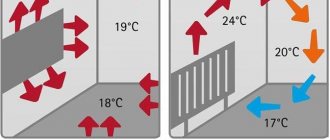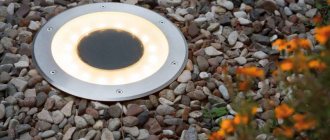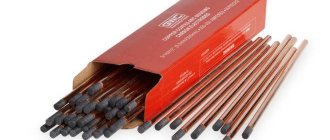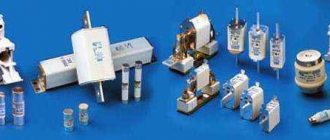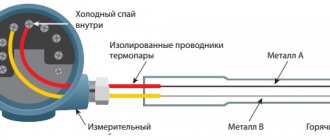Today, thermal infrared panels are increasingly used for heating residential premises. They are highly efficient, practical, compact and attractive in appearance. The automation built into IR heaters allows you to easily control the operating parameters of the devices themselves. The main disadvantage of infrared heating is its dependence on expensive electricity. At the same time, it has many advantages, thanks to which it is gradually gaining immense popularity.
Construction of a house with infrared heating Source ultra-term.ru
What is infrared heating
With traditional space heating, warm air constantly moves upward. Therefore, the space under the ceiling always warms up more than above the floor. When using an infrared heating system, furniture, walls, ceilings, and flooring are first heated. They then release the accumulated heat to the environment. As a result, a uniform distribution of thermal energy throughout the room is achieved, and people in it feel as comfortable as possible.
IR heating is used as independent or auxiliary. In this case, it is possible to organize local heating of rooms, when heat is supplied only to certain zones. The latter is especially true for huge rooms with high ceilings. In addition, this type of heating allows for efficient heating of open areas, including street ones.
Infrared heaters provide the most economical electric heating Source autodela.ru
Manufacturers of IR heaters
Many companies around the world are engaged in the production of IR equipment. The most popular among foreign manufacturers are:
- "STIEBEL ELTRON" is a German company that produces products of traditionally high quality;
- FENIX TRADING - a Czech company pays close attention to the issue of energy efficiency of its products;
- “AIR COMFORT” - the Italian concern is betting on creating a safe heating system of a new generation;
- "FRICO" - a Swedish manufacturer guarantees Scandinavian quality and places increased demands on the design of its products.
Domestic manufacturers are represented by such trademarks as Bilyuks , Peony , EcoLine , Almak . In terms of quality characteristics, the products of these brands are not much inferior to their imported counterparts.
The cost of domestic-made IR equipment is 30% lower than imported analogues, so a wide range of buyers can afford its installation
But it is worth noting that not all of these domestic devices for infrared heating are supplied complete with brackets. In addition, judging by the reviews, the operation of domestic devices is often accompanied by a slight crackling sound, which can be annoying especially at night.
You should also be wary of Chinese-made products. CE mark on their products , indicating “ China Export ”. CE mark , which stands for “ Conformite Europeenne ”.
The only difference is that in the second case the font density is a little wider and the letters are located a little further from each other. Therefore, in addition to studying the labeling, ask for certificates of conformity.
Operating principle
Thermal radiation emanating from IR heaters is not absorbed by the air. It reaches directly objects and people, who then transfer heat to the environment. The high efficiency of infrared heating devices is due to the following: any surfaces in the house perfectly absorb infrared rays. Furniture, after sufficient heating, turns into a heat source.
The infrared heater contains an aluminum plate and a heating element, which heats it up to 250°C. After heating, the plate emits waves of the electromagnetic type. In this case, the device body does not reach a high temperature (maximum 80°C).
Infrared heaters are compact in size, easy to use, and demonstrate high operating efficiency Source eurosantehnik.ru
Important! During operation, infrared heating panels do not absorb oxygen at all. Therefore, they are excellent for creating a healthy microclimate in apartments, houses, offices, and industrial premises.
To ensure that the thermal energy generated inside the home remains in the rooms, infrared heating panels should not be directed at the ceiling, walls, or doors Source domsireni.ru
Impact on humans
Like any other radiation, infrared waves can be harmful to health. The degree of influence depends on the wavelength. Short-wave “luminous” heaters with a wavelength of up to 3 microns provide quick heating of open areas of the floor and surfaces of objects, but can lead to overheating of the upper layers of the skin, drying it out and even burns. Such emitters are used in solariums.
The most comfortable for humans are heaters with an operating wavelength of more than 7 microns. Such waves penetrate deeper into the body, but do not have a burning effect and are not harmful to health.
Types of devices
Based on their installation location, all infrared heating panels are divided into 3 groups: wall, ceiling, floor. The difference between them is only in the installation diagram and the presence of certain useful functions.
Wall mounted
Most often they are mounted in a niche under a window or at the bottom of the walls. They are made similar to existing central heating radiators. IR heaters differ from the latest ones only in the flat shape of their surfaces. In terms of efficiency, they are not at all inferior to other varieties of similar devices.
All wall heating panels contain a thermostat and systems that protect against possible overheating. Such devices are slightly heavier than floor-mounted and wall-mounted ones; they are installed for a long time, while immediately taking into account the design features of the room. Sometimes during the installation of devices all kinds of decorative elements are used: ornament, stucco, stone.
In most cases, household IR wall heaters emit waves with a length from 5.6 to 100 microns Source stroy-podskazka.ru
Ceiling
In appearance they often resemble lamps, but at the same time they are distinguished by their relatively large size and considerable weight. Ceiling heaters are not entirely suitable for installation in living rooms; they are more recommended for use in offices, garages, and industrial premises.
The main advantages of heaters that are mounted on the ceiling are high power, the presence of a thermostat, and large area coverage. The latter allows the use of ceiling heating panels for high-quality heating of large rooms. Such devices are controlled via a remote control, which is extremely convenient for users.
Ceiling infrared heaters are most often used in rooms with a large area, they differ in overall dimensions and considerable weight Source twoidvor.com
Classification according to the method of arrangement of elements
Infrared heating devices are presented on the market in a wide range. According to the method of arrangement of heating elements, they can be divided into three groups: floor, wall and ceiling.
Option #1 - floor heaters
Floor coverings are modular materials, inside of which flat heating elements are laid. The coating is produced in the form of rolls. For installation, it is cut into pieces of the required sizes.
Strips of rolled material are placed on the floor so that the emitters do not end up under heavy furniture; this will prevent a decrease in heat transfer and drying out of the wooden elements of the set
The insulating material and infrared film are laid directly on the prepared base floor. During the installation process, avoid placing the panels overlapping and try to maintain a distance of 10-15 cm from the walls.
The following can be laid on top of floor infrared strips:
- carpet;
- parquet board;
- linoleum;
- laminate;
- ceramic tiles.
The most successful combination is obtained when using ceramic tiles as a floor covering. Laminate is a little inferior in this regard. And the greatest shielding of IR radiation is created by carpet and linoleum.
Film systems are installed not only on floors, but also on ceilings under suspended structures and attic roof slopes. Installation and connection are carried out according to a similar scheme:
Image gallery
Photo from
Preparing IR film for installation on the ceiling
Film heating construction process
Preparing the heating system for finishing
Connection to control unit
Infrared heating systems include not only film options, but also rod carbon floors. A popular article on our website will introduce you to the rules for installing them.
Option #2 - wall and ceiling fixtures
Compared to underfloor heating systems, the choice of ceiling and wall-mounted units is wider. In addition to traditional panels, there are also designer built-in models of ceiling radiators.
They can be installed in suspended ceilings. They are available for sale in different sizes and colors.
The plates are placed in such a way that the rays emanating from them are directed to the furniture, and the latter, having absorbed heat, begins to act as a source of thermal energy
Ceiling models of infrared emitters are located at a height of 3 meters and above. With this arrangement, the thermal ceiling is directed downward and diverges slightly to the sides.
Rushing down, the rays first warm up the floor covering. Due to this, the temperature at the level of the feet is always a couple of degrees higher than in the head area. To prevent heat from leaking into the street, the panels are not placed opposite doors and window openings.
Wall-mounted infrared emitters are placed so that they are above or below the level of a person’s head
Among wall emitters, it is worth highlighting baseboard systems. They are narrow, long structures. The systems are installed around the perimeter of the room, placing them instead of conventional plastic or wooden baseboards.
When choosing a location for placing panels, you should avoid recreation areas where there is a high probability of direct impact on household members. For example: at the level of a sofa or bed.
Otherwise, the rays directed at right angles will overheat and dry out the skin, causing discomfort among residents and guests of the house. The coverage area of directional emitters is one of the main characteristics and is usually indicated in the product data sheet.
IR wall heaters are rarely used. The circulation of warm and cold air occurs from bottom to top, so it is wiser to prefer ceiling or floor options
Advantages and disadvantages
Like any other, infrared heating system has advantages and disadvantages. Its positive aspects include the following:
- the room can be heated to 50°C;
- when operating IR heating panels, normal humidity and optimal temperature conditions are ensured;
- during operation of infrared devices, no convection air currents are formed, therefore there is no dust in the house;
- the presence of a thermostat allows you to maintain a certain temperature indoors and save energy;
- infrared heating panels can be placed both on the ceiling surface and on the walls;
- IR devices minimize the temperature difference at the ceiling and at floor level;
- due to the slight inertia of the infrared system, heating of the room begins immediately after it is turned on;
- long service life - 50 years;
- environmental Safety.
Voltage drops in the network are not critical for infrared panels, therefore they are considered quite reliable Source s.06153.com.ua
Scope of application
Despite the fact that some PLEN manufacturers position their products as an alternative to central heating, independent use of that system for heating a summer house, house, store, warehouse or other type of building in winter is not economically profitable. To do this, it is better to use a water boiler and a tubular floor heater, despite the fact that the installation of such equipment is much more complicated. As for industrial and production premises, gas emitters are more suitable for them.
Gas-radiant heating of the workshop is most efficient when installed on the ceiling
The ideal application area for IR films is an auxiliary heating system, which is used to heat a nursery, loggia, French balcony or floors of a private house.
This system can also be used to heat small auxiliary spaces, such as a garage, poultry or chicken coop, basement, etc. PLEN is often used as a soil heater in a polycarbonate greenhouse.
Taking into account the facts stated above, it can be stated that the efficiency of PLEN decreases with increasing heating area.
How to choose the right one
Before purchasing equipment for installing infrared heating, you should decide for what purpose it is planned to be used. If the selected model will serve as the main heating source, it is extremely important to pay attention to its power. It must be at least 100 W/m2. If the ceiling height in the room is more than 3.5 m, then you should focus on the minimum value of 120 W/m2.
Other factors influencing the choice of an infrared heating device:
- Features of the walls of the premises: type, presence of insulating material.
- Glazing quality. The type of windows installed and the presence of energy-saving glass in window structures are important.
- Ceiling characteristics. The current state of the ceiling is considered. It also matters what is located on top: another apartment or a roof.
The listed factors greatly influence the heat loss in the room, and therefore the calculation of the power of the future IR heater.
Before purchasing an infrared heater, you should calculate its power by first measuring the area of the room and the height of the ceiling Source stroy-podskazka.ru
Best models
Various manufacturers in Europe and Russia produce home heating equipment. In this rating of infrared heaters, the best models that have collected positive customer reviews are selected.
1st place - Ballu BIH-AP4-0.8-W
The cost of this model is around 3000 rubles. This heater is designed to heat an area of 16 square meters, connects to a 220/230 V system and is installed at a recommended height of 2.4–3.5 meters, its power is 800 W.
Based on reviews, we find out that this is an effective and high-quality model that warms up the room quickly enough. The set includes durable brackets - with their help the device can be rotated. This model is mainly used as an additional source of heating in any room, but is also suitable for a garage and for installation outdoors - the waterproof housing will not allow rain to spoil it.
2nd place - Almac IK5
This infrared heating battery has a lower power of 500 W. It effectively heats 10 square meters, so in a single copy it is used as an additional heat source. However, three similar models can easily cope with heating a large living room or hall.
Judging by the reviews, the device effectively copes with its task, is easily attached to the wall or suspended from the ceiling, and is simply adjustable - it is enough to set 23 degrees during the day, 20 at night. The only drawback is the complexity of the connection. And although the instructions indicate how to install an infrared heater, the kit does not include wires and a thermostat, so without the appropriate knowledge and experience you cannot connect it - you will have to call a specialist, but you can turn a blind eye to this, given the low price of around 2,500 rubles.
3rd place - Peony Thermo Glass P-10 (7000 rubles)
The model is from the Russian one, which has become popular on the Russian market. Power – 1000 W, heating area – 20 m². The device is connected via a regular 220/230 V socket and is equipped with electronic control and a thermostat, which allows you to accurately regulate the power and heating temperature. It also received protection against overheating, which ensures minimal safety and increases its service life. The infrared heater can be installed on the ceiling at a height of 2.3–3.5 meters.
According to reviews, the model is effective: it quickly heats surrounding objects, operates silently and provides soft and pleasant warmth. This is an advantage, since some models heat aggressively.
The disadvantage is the equipment and high price. The model is significantly more expensive than similar heaters, and the kit does not include any cables. The device also needs to be looked after - if you do not systematically wipe the dust off it, then over time a burning smell will appear.
There are also many low-quality products on the market with the CE mark. In one case it means “Conformite Europeenne”, in the other it means “China Export”. Try to choose reliable equipment, since heating devices in the house always pose a certain danger.
Installation features
The installation procedure for infrared heating panels is not complicated: just follow the instructions in the instructions. It can be found on the website of the manufacturer of the purchased equipment. After completing the installation work, you only need to plug in the device into the electrical network.
IR heaters are mounted on walls and ceilings. When choosing a ceiling device, you should consider the following recommendations:
- It is important to prepare suitable fasteners: they must be strong in order to reliably hold the weight of the device being installed.
- The heater is fixed using the fasteners that come with it. Often these are steel chains and rigid brackets.
- During the installation process, it is necessary to prevent contact of the heating surface with flammable substances and materials.
- Using a special tape, it is important to insulate the electrical wiring contacts.
Adviсe
The decision to install a particular heating system in a private home should be made carefully, since few people decide to redo the entire property. If there are problems with the gas supply, then you can choose an alternative - PLEN heating.
Laying PLEN on the floor
It is easy to install it yourself, but do not forget about the choice of finish. And also correctly calculate the required power and location of the thermostat. During operation, you will appreciate all the benefits of “warm film” in your home.
One of the most pressing issues for owners of country houses, cottages, dachas, bathhouses, and other country-type buildings is the issue of heating. Today there are three main types: solid fuel, gas and electric heating. Let's try to figure out which one is better. Let's calculate three options for heating a small country house of 90 m 2.
Alternative and traditional heating of a country house prices and options
Let's consider the main types of fuel that can be used to heat private households in our latitudes:
- firewood and coal;
- fuel oil, diesel, gasoline, mining;
- network and bottled gas;
- electricity (grid, solar or wind);
- geothermal energy.
Each of the listed types has its pros and cons
When choosing the type of heating, it is important to take into account the financial capabilities of the family to purchase and operate the system, the availability of fuel and the possibility of combining different types of fuel
It is worth considering that cheap equipment is usually short-lived
Saving on qualified technicians can result in system problems
That is why it is important to think through everything down to the smallest detail, draw up a project competently and entrust the work to professionals



